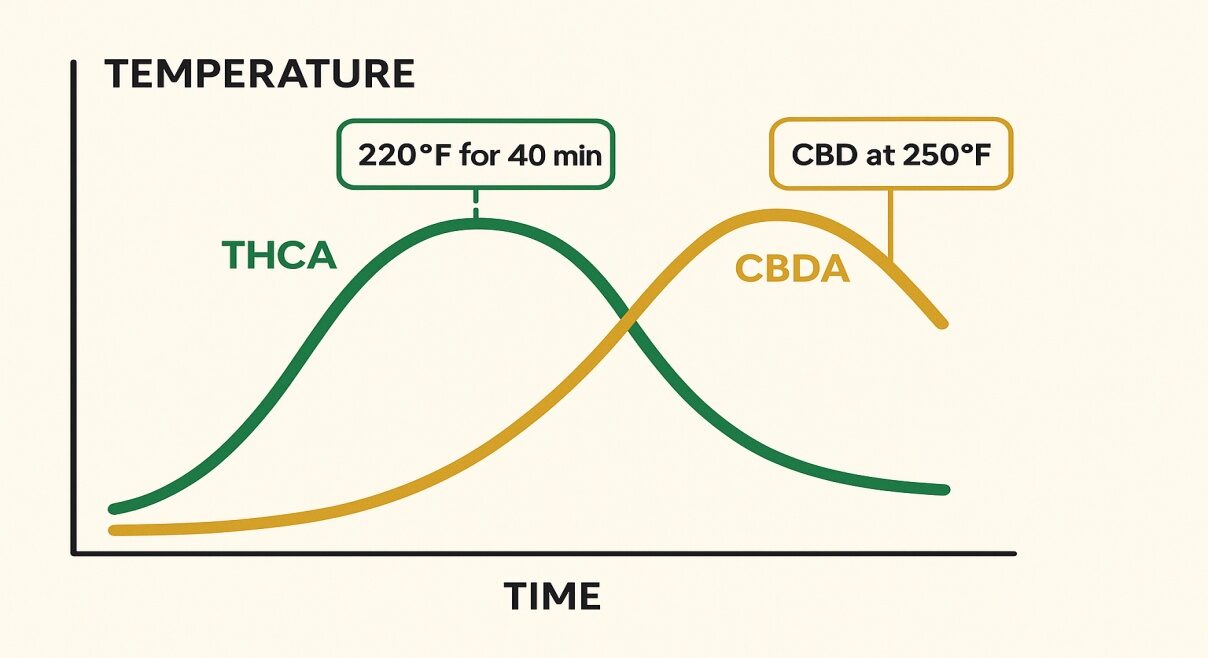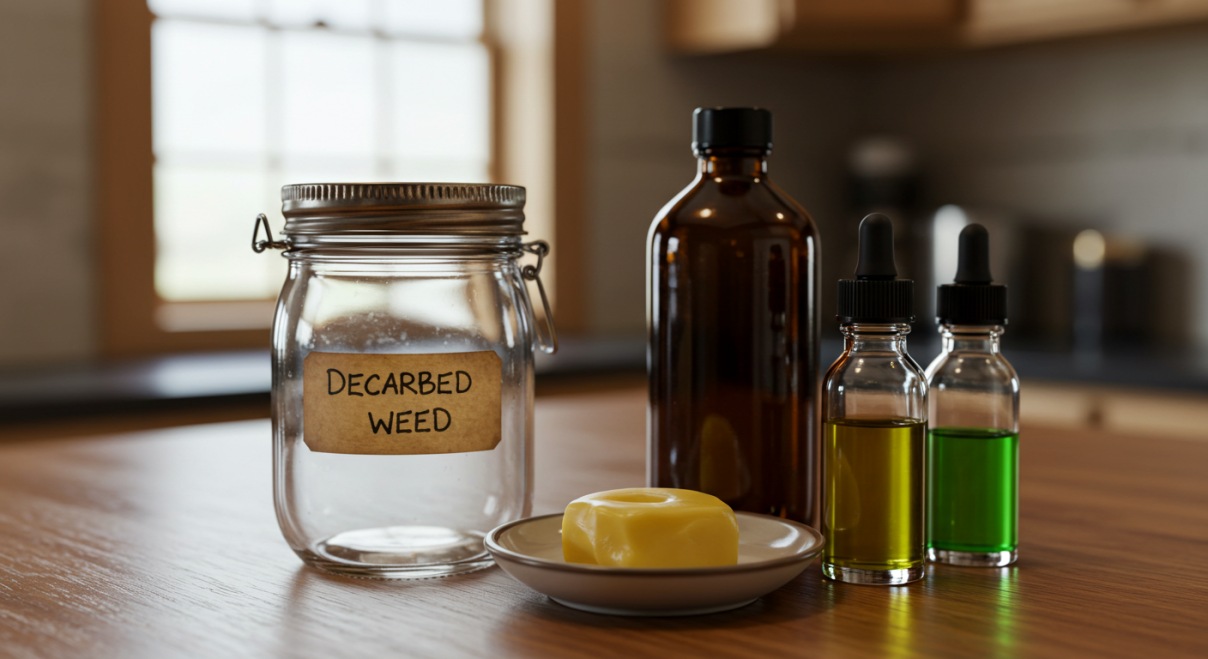
If you’ve ever made edibles that hit like a wet noodle instead of a freight train, odds are you skipped or messed up the most important step: decarboxylation.
Decarbing weed sounds like science class, but it’s really just a fancy word for heating your cannabis the right way so the good stuff like THC and CBD, actually works. Whether you’re making brownies, butter, tinctures, or just trying to boost the potency of your smoke sesh, this guide breaks it all down in simple, no-BS terms.
What Is Decarboxylation (And Why Should You Care)?
When you smoke weed, the flame automatically decarbs your bud. But when you’re eating it, vaping it at low temps, or making topicals, you’ve gotta do the science part yourself.
The Science-y Part (But Easy to Understand)
Raw cannabis is full of THCA and CBDA, which are the acidic, non-psychoactive versions of THC and CBD. These don’t get you high until you heat them up.
Decarboxylation = heat + time → THCA becomes THC
No heat = no high.
The chemical change looks like this:
- THCA → THC + CO₂
- CBDA → CBD + CO₂
You’re literally baking off the carboxyl group (that’s the “decarb” part), which releases carbon dioxide. Once that happens, your cannabinoids are ready to bind with your body’s endocannabinoid system and actually do something.
Why Decarb Cannabis?
So it actually works. But here’s the breakdown:
| Reason | What Happens |
|---|---|
| Edibles | Without decarbing, your brownies are just expensive spinach. |
| Topicals | For pain relief, you want activated cannabinoids. |
| Tinctures/Oils | Activated THC and CBD are absorbed better. |
| Vaping | Some lower-temp vapes won’t fully decarb on their own. |
| Infusions | THC binds to fat and alcohol after it’s activated. |
Bonus: Shelf Life
Properly decarbed and stored weed can last longer. Raw flower degrades into CBN faster. Activated weed (especially in oil) stays potent for months if stored in a cool, dark place.
How to Decarb Weed (Step-by-Step)
Let’s cut through the nonsense. Here’s how to decarb flower the right way.
What You’ll Need:
- Cannabis (duh)
- Oven
- Baking sheet
- Parchment paper or foil
- Oven thermometer (optional but helps a lot)
Method: Oven Decarb
- Preheat your oven to 240°F (115°C)
Most sources agree this is the sweet spot, hot enough to decarb, cool enough to keep terpenes intact. - Break up your bud
Don’t grind it too fine, just crumble it into popcorn-sized chunks for even exposure. - Line a baking sheet with parchment paper
This helps prevent sticking and protects from direct contact with the hot pan. - Spread your cannabis evenly
One even layer, no stacking. - Bake for 30 to 40 minutes
Stir halfway through for even exposure. - Let it cool completely
It’ll be dry, crumbly, and a light toasty brown, not black. If it smells like burnt popcorn, you went too far.
Pro Tip:
Every oven runs a little different. Use an oven thermometer to dial in the actual temp 240°F on the dial could be 260°F in reality. Go low and slow.
Advanced Methods (and Why You Might Use Them)
Oven works for most people. But if you’re extra about your terps, want more control, or hate that “weed smell” in your kitchen, try one of these.
1. Mason Jar Method
- Bud goes in a mason jar with a lid (not too tight).
- Place in oven at 240°F for 40-60 mins.
- Shake gently every 15 mins.
Pros:
- Less smell
- Preserves terpenes
- Even heating
Cons:
- Takes longer
- Risk of jar cracking (don’t preheat the jar)
2. Sous Vide
- Vacuum-sealed or Ziploc bag of bud
- Submerged in 203°F water bath for 90 mins
Pros:
- Super terpene-friendly
- No smell
- Precise temperature control
Cons:
- Needs a sous vide machine
- Long wait
3. Decarb Machines (Like Ardent or Magical Butter)
- Put weed in, press a button, done.
Pros:
- Foolproof
- Smell is contained
- Accurate and consistent
Cons:
- Pricey upfront
- Not necessary for small batches
Time & Temp Table: Decarboxylation Cheat Sheet
| Cannabinoid | Ideal Temp | Time | Notes |
|---|---|---|---|
| THC (from THCA) | 220-240°F | 30-40 mins | Most common |
| CBD (from CBDA) | 240°F | 40-60 mins | Needs a bit longer |
| CBG | ~220°F | 30-40 mins | Less research, but similar |
| THCV | 295°F | 15 mins | Higher temp, quicker burn |
| CBN (oxidized THC) | 320°F | N/A | Not decarbed, aged |
Does Butter or Oil Alone Decarb Weed?
Short answer: kinda, but not really.
Cooking weed in butter at 160-180°F won’t fully decarb it. You’ll get some activation, but not max potency. For real results, decarb first, then infuse.
If you’re making canna-oil, don’t skip the oven step. You’ll end up with weak edibles and wasted weed.
What Happens If You Don’t Decarb?
- You’ll still get some effects (especially if the oil or dish gets hot enough).
- But you’ll miss out on the full punch of THC or CBD.
- Think of it like trying to use instant coffee grounds without boiling water. You’ll get something, but not what you were hoping for.
Potency & Bioavailability
Decarbing increases the bioavailability of cannabinoids basically, how well your body can absorb them.
Here’s how they compare:
| Format | Bioavailability | Decarb Needed? |
|---|---|---|
| Smoking | ~30% | Already decarbed by heat |
| Vaping | ~35-56% | Some temps may need pre-decarb |
| Edibles (oil) | ~4-12% | Needs decarbing first |
| Tinctures (alcohol) | ~20-30% | Decarbing optional for raw THCA/CBD effects |
Terpenes & Decarbing: Will I Lose Flavor?
Yes… unless you’re careful.
Terpenes are delicate little molecules. Most boil off around 250°F, so if you crank your oven to 300°F, you’re basically blasting away your weed’s flavor and effects.
How to preserve terps:
- Use lower temps (220-230°F)
- Decarb in sealed jars or with sous vide
- Infuse immediately after decarbing
Legal Stuff: Is Decarbing Illegal?
Decarbing your own cannabis is usually legal if weed is legal where you live. Once THC is “activated,” it’s technically a controlled substance in stricter states or countries. In other words:
- Legal state? You’re good.
- Illegal state? Activated THC might get you in more trouble than raw flower.
Check your local laws before making edibles or concentrates.
Testing Your Decarbed Weed (Kind of Tricky)
Home testing isn’t super reliable, but if you want to test potency:
- Use to Check (for infused oils)
- Send samples to a lab (if legal in your area)
- Estimate with online calculators (not super accurate)
Unless you’re making edibles commercially, it’s usually fine to follow time/temp best practices and use strain data as a rough guide.
Pros & Cons of Decarbing Weed
| Pros | Cons |
|---|---|
| Maximizes potency | Smells up the house |
| Makes edibles work | Can burn if overheated |
| Easy to do at home | Takes time and attention |
| Lets you use every part of the plant | Some terpene loss |
Final Thoughts: Don’t Skip This Step
If you’re gonna eat, infuse, or store your weed for long-term use, decarbing is non-negotiable. Think of it like toasting your spices before cooking, it unlocks the flavor and potency you’re actually paying for.
Start low, watch the temp, and remember: no one brags about the weed they wasted by skipping decarb.
Common Decarb Questions
1. Can I decarb stems or leaves?
Yes, but they’re low in THC. Use for tea or topicals.
2. How long does decarbed weed last?
Stored right (cool, dark, airtight): 6-12 months easily.
3. Does decarbing smell bad?
Yeah, a little. It smells like a dispensary in your kitchen. Use a jar or decarb machine to cut down the odor.
4. Can I vape decarbed weed?
Yes. It still has cannabinoids, but less flavor. Some people even eat the leftover AVB (Already Vaped Bud) because it’s partially decarbed.
5. Is AVB fully decarbed?
Mostly. It depends on how hot and how long you vaped. Still good for edibles and capsules.
6. What is decarboxylation in cannabis?
Decarboxylation is the process of applying heat to cannabis to activate its psychoactive compounds. Raw cannabis contains THCA and CBDA, which are non-psychoactive. Heating converts these into THC and CBD, which can interact with the body’s endocannabinoid system.
7. Why is decarboxylation necessary for edibles?
Without decarboxylation, edibles would contain inactive cannabinoids, resulting in minimal psychoactive effects. Decarbing ensures that the THC and CBD are activated, making the edibles effective.
8. What temperature should I use to decarb cannabis?
The optimal temperature range for decarboxylation is between 220°F to 240°F (104°C to 116°C). This range effectively activates cannabinoids while preserving terpenes.
9. How long should I decarb cannabis?
Typically, decarboxylation takes about 30 to 40 minutes at 220°F to 240°F. The exact time can vary based on the moisture content and density of the cannabis.
10. Can I decarb cannabis in a microwave?
While it’s possible to decarb cannabis in a microwave, it’s not recommended due to uneven heating and the risk of burning. Using an oven provides more consistent results.
11. Does decarboxylation produce a strong odor?
Yes, decarboxylating cannabis releases a strong, distinctive odor. To minimize the smell, consider using a sealed container or decarboxylation device.
12. Can I decarb cannabis in a smoker?
Decarbing cannabis in a smoker is possible but challenging due to temperature fluctuations and smoke exposure, which can degrade cannabinoids and terpenes. It’s better to use controlled methods like an oven or decarboxylation device.
13. Is decarboxylation necessary for making tinctures?
Yes, decarboxylation is essential for tinctures if you want the psychoactive effects of THC. Without decarbing, the tincture will primarily contain THCA, which is non-psychoactive.
14. What does decarboxylated cannabis look like?
Decarboxylated cannabis appears slightly darker and drier than raw cannabis. It may have a light brown or golden hue and crumble easily.
15. Can I decarb cannabis that’s already in oil or butter?
Decarboxylation should occur before infusing cannabis into oil or butter. Attempting to decarb cannabis that’s already in oil or butter can lead to uneven activation and potential loss of potency.
Sources:
- https://www.leafly.com/learn/consume/edibles/what-is-decarboxylation
- https://weedmaps.com/learn/the-plant/the-ultimate-guide-to-decarboxylation
- https://www.wikihow.com/Decarboxylate-Cannabis
- https://sunsetlakecbd.com/how-to-decarboxylate-cannabis/


